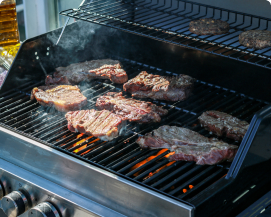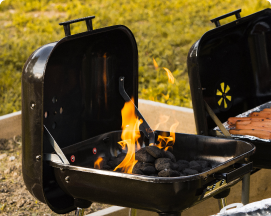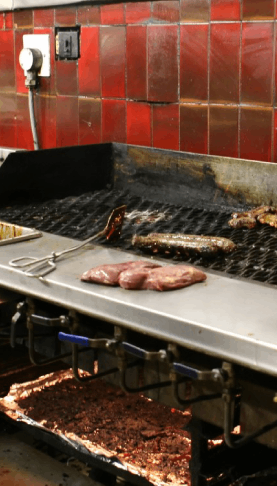If you run a restaurant kitchen in Salt Lake City and you just want the short version, here it is: talk with a qualified Salt Lake City electrician, keep your circuits clearly labeled and not overloaded, install plenty of GFCI outlets near water, schedule regular panel and hood inspections, and train your team to respect electricity as much as they respect a sharp knife. Everything else in this article is really just explaining those points in more detail, with some real world examples and a few things I have seen go wrong.
Why restaurant kitchens in Salt Lake City have their own electrical quirks
Restaurant kitchens are rough on electrical systems. Heat, moisture, grease, constant movement, and long hours all put strain on wires, outlets, and equipment.
I think many people underestimate this part. They plan the menu, the decor, the social media, and then assume the original electrical setup will be fine. Sometimes it is. Often it is not.
In Salt Lake City, you also have older buildings mixed with newer construction. Some kitchens are in converted houses or historic spaces. Others are in modern shells that started as something else and turned into a food spot later. That mix creates some strange electrical setups.
Most hidden fire risks in kitchens come from small electrical shortcuts that no one notices until something fails.
If you care about cooking and you want your team and guests to stay safe, it helps to understand a few basics. You do not need to become an electrician. But you will make better choices if you know what to look for and what to question.
Planning your kitchen layout with electricity in mind
Many owners and chefs start with the menu and equipment list. That part makes sense. But electrical planning should sit right next to that, not after it.
Map equipment before you buy everything
Before you order that extra fryer or a second combi oven, sketch out where everything will live. Then consider the power needs of each item.
Ask yourself:
- Does this piece of equipment need 120V or 240V?
- How many amps does it draw at full load?
- Will it run at the same time as several other heavy appliances?
- Is it near water or steam?
- Is it mobile, like a cart, or fixed in one spot?
That list looks simple, but many buildouts skip at least half of those questions and just start plugging things wherever an outlet exists. Then the tripping breakers start, or worse, outlets start to feel hot.
Think about workflow and outlet placement
As you picture your cooks moving during a rush, think about where cords will fall. You do not want tangled cords where people pivot, or power strips hiding behind flour bins.
Some spots often need extra outlets:
- Prep tables for mixers, immersion blenders, and scales
- Dessert or pastry section with stand mixers and small ovens
- Expediting window for heat lamps and POS equipment
- Bar area for blenders, juicers, and refrigeration
If you keep reaching for extension cords in the same area, you do not need more cords, you need more outlets on the right circuit.
I think one good habit is to walk through a fake Friday night in your head. Imagine every station running full blast. Then ask: where would people fight over outlets? Where would you feel tempted to daisy-chain power strips? Those spots need attention early.
Circuits, loads, and why breakers keep tripping
Breakers that trip sometimes are not just annoying. They can be early warnings.
Know roughly what is on each circuit
You do not have to memorize amperage numbers, but it helps to have a basic idea of what each breaker covers. A clear panel schedule is key. Many panels in restaurants are messy, with labels like “kitchen” or “misc.” That is not useful.
A cleaner version might look like this:
| Breaker number | Area | Equipment / outlets | Notes |
|---|---|---|---|
| 5 | Line cook station | Flat-top, undercounter fridge | 20A, 240V |
| 7 | Prep area | GFCI outlets by sink, mixer | 20A, 120V |
| 9 | Dish area | Dishwasher, booster heater | Dedicated, 30A |
| 11 | Bar | Underbar coolers, blender station | Two circuits shared |
This kind of chart does not have to be fancy. It just needs to be accurate, and it needs to sit right next to the panel. A licensed electrician can help you sort this out if it already feels confusing.
Common overload mistakes in restaurant kitchens
Here are a few patterns that cause trouble in real kitchens:
- Several high draw appliances on the same 20A circuit, all running during peak hour
- Adding equipment without checking panel capacity first
- Using plug in air conditioners or heaters in the kitchen that share circuits with cooking gear
- Sharing a circuit between undercounter refrigeration and high heat appliances
If a breaker trips now and then when everyone pushes hard, that might be expected. If you have to reset the same one several times a week, something is wrong. At that point, guesswork stops helping.
A breaker that trips often is not “doing its job too well”; it is telling you the wiring or the load plan needs to change.
GFCI outlets and moisture heavy areas
Water and electricity do not mix. Everyone knows this, but in real kitchens, people still plug things into non protected outlets next to sinks, mop stations, and dish pits.
Where GFCIs belong in a restaurant kitchen
GFCI protection cuts power fast when it senses current leaking to ground. That can protect a person from a serious shock. Codes change over time, but a simple mental rule helps:
- Any outlet close to a sink or other water source should be GFCI protected
- Outlets near mop sinks and janitor closets should be protected
- Bar outlets around ice bins and glass washers should use GFCIs
- Outdoor patio service stations need GFCI protection
Some people complain that GFCIs trip too often in kitchens. That can happen with certain appliances. But the answer is not to remove them. The answer is to have a qualified electrician review the setup and balance protection with reliability.
Check GFCIs regularly
Most GFCI outlets have “test” and “reset” buttons. Many restaurant staff never touch them. That is not ideal.
Here is a simple routine you can add to your monthly checklist:
- Pick a slow time during the day
- Press the “test” button on each GFCI outlet
- Confirm power cuts to that outlet and any downstream outlets
- Press “reset” and confirm power comes back
If an outlet will not reset or behaves strangely, leave it alone and mark it for your electrician. Do not tape it, do not jam it, do not smack it with a spoon. That sounds obvious, but I have watched people do all of those.
Cords, power strips, and the trap of temporary fixes
In a busy kitchen, extension cords feel like a simple way to solve problems. They are flexible. They let you add one more piece of gear without calling anyone. They also create trip hazards and fire risks.
Where extension cords are especially risky
Areas that worry me most are:
- Dish pits, where cords run across wet floors
- Walkways between line and expo station, where people pivot with hot pans
- Prep areas where cords can get covered with flour, oil, or water
- Rooftop or outdoor cooking setups for events
Many cords used in kitchens are not rated for that environment. The insulation can break down under constant heat and moisture. Once the outer jacket is worn or cut, you have exposed conductors in a tough spot.
How to handle “temporary” needs the right way
Sometimes you do have a short term need, like a seasonal prep station or pop up bar for a holiday menu. In that case:
- Use heavy duty cords that are rated for commercial use
- Keep connections off the floor and away from spills
- Protect cords with proper cable covers where people walk
- Never plug a power strip into another power strip
If a “temporary” setup is still there after a month or two, you can probably assume it is not temporary any more. At that point, it is worth having a professional add permanent outlets or circuits instead of trusting a patchwork of cords.
Panels, breakers, and when to think about an upgrade
Many restaurant owners know every detail of their ovens and refrigerators but have never opened the electrical panel door. I get it, panels look boring. But they tell you a lot about the health of your kitchen power.
Signs your panel might be overloaded or outdated
You might need an electrician to look closer if you see things like:
- Frequent nuisance tripping on busy nights
- Labels that do not match which breaker controls which area
- Double tapped breakers where two wires share a spot meant for one
- Corrosion, rust, or burn marks inside the panel
- No room left for new breakers, yet more equipment keeps getting added
Salt Lake City has many buildings from different eras. Some older panels were not built for modern commercial kitchen loads. If your panel is decades old and your equipment list keeps growing, that is a strong reason to ask a licensed electrician whether panel replacement or a service upgrade makes sense.
Why more power is not always the first solution
There is a small trap here. Some people think “we just need more power” and rush into major upgrades. Sometimes that is true. But in other cases, the real need is better load distribution and smarter circuit layouts.
For example, moving certain appliances to separate circuits or staggering when high draw equipment cycles on can reduce stress. A good electrician will look at both options, not just sell the biggest panel on the market.
Kitchen equipment: what an electrician sees that cooks might miss
Cooks and owners see equipment in terms of performance and maintenance. Electricians see how that gear pulls power and how it can fail electrically.
High draw appliances that deserve extra respect
Some kitchen equipment pulls a lot of current:
- Electric fryers
- Flat-tops and griddles
- Combi ovens
- Electric ranges and ovens
- High volume dishwashers and booster heaters
These are pieces that should almost always have dedicated circuits with correctly sized breakers and wires. Plugging a powerful new fryer into a convenient outlet that used to serve a small fridge may seem fine at first, but it can overheat wiring inside walls.
Watching for early warning signs on equipment
Your team spends the most time with the equipment. You can train them to notice warning signs like:
- Plugs or cords that feel hot to the touch
- Outlets that are discolored or smell burnt
- Equipment that dims lights or causes flicker when it cycles on
- Repeated need to wiggle a plug to get power
These are not things you “live with.” They are signals to schedule a check. Waiting until something fails at 7 p.m. on a Saturday is much worse.
Kitchen hoods, exhaust fans, and make up air
Hood systems are often seen as mechanical, but they tie closely into electrical safety.
Why hoods matter for electrical safety
If your hood and exhaust fans do not pull smoke and grease vapor away effectively, that residue lands on walls, ceilings, lights, and outlets. Over time, that film can affect connections and fixtures.
Grease and dust can:
- Settle on light fixtures and raise temperature
- Coat outlet covers and switches
- Build up on fan motors and reduce cooling
All of that adds heat stress. Heat plus electricity is not a friend pair.
Interlocks and emergency shutoffs
Many modern systems tie cooking equipment to the hood operation. That means if the hood fan stops, certain appliances cannot run. Some local codes also require clear emergency shutoff switches for gas and electric cooking lines.
Do your staff know where these shutoffs are and when to use them? In some sites I have visited, the emergency switches are hidden behind stacked boxes or used as informal shelves. That is more common than people admit.
Walk your team through those controls on a slow day. Let them flip the switch and see what happens. Familiarity in a calm moment can prevent panic when something actually goes wrong.
Lighting in the kitchen: not just a comfort issue
Good lighting affects food quality and safety. It also affects how hard your electrical system works.
LED vs older lighting types
Many kitchens still run older fluorescent or even incandescent lighting in some corners. Upgrading to LED can reduce heat and reduce load on your circuits.
Some benefits:
- Lower power draw per fixture
- Less heat near ceilings and hood areas
- Better color rendering for food
- Longer lamp life, fewer ladder trips during prep
One caveat: mixing low quality LED fixtures with older wiring can produce flicker or buzzing. If lights behave oddly after a change, that is another time where an electrician can test and adjust drivers or circuits.
Emergency and exit lighting
If power fails in the middle of service, staff still need to see the path to exits and to shut down equipment safely. Many codes require emergency lighting and clear exit signs that kick in during outages.
These parts of your system have batteries or separate circuits. They should be tested on a regular schedule, not just trusted blindly. Combine this with your GFCI tests and you already have a simple monthly safety routine.
Training your staff to respect electricity
Most training in kitchens focuses on food safety, knife skills, and fire safety with grease. Electrical safety often lives in the background, until a shock or fire scares everyone.
Short training topics that actually help
You do not need long lectures. Short, focused points are enough if they repeat now and then. Topics could include:
- How to unplug equipment by the plug body, not by yanking the cord
- Why outlets should not be covered with foil, tape, or plastic wrap
- What to do if they see sparks, smell burning, or feel a shock
- Why GFCI outlets trip and why nobody should bypass them
- Where the main electrical panel and emergency shutoffs are
I think it helps to be blunt here. Explain that electricity can kill, and that you would rather get a late night phone call about a weird smell than wake up to news of a fire or injury.
A no blame culture around reporting problems
If your staff feel they will be yelled at because a breaker tripped, they might hide early warning signs. That silence can cost you more later.
Encourage them to report issues like flickering lights, warm outlets, buzzing panels, or small shocks. Even if it turns out to be nothing serious, they did the right thing. That attitude pays off over years.
Scheduling regular electrical checkups
You probably already have regular visits for hood cleaning, fire extinguishers, and sometimes HVAC maintenance. Electrical systems deserve a similar calendar slot.
How often should a restaurant kitchen get inspected?
The answer depends on how heavy your load is, how old the building is, and how often you change equipment. But as a ballpark:
- A quick visual check of panels, outlets, and cords by management every month
- A more detailed review by a licensed electrician every 1 to 3 years
- Extra visits after major remodels or big equipment changes
In some cases, your insurer might even give better terms if you can show documented inspections. That is worth asking about, because it links safety to real money saved.
What a good electrician looks at in a restaurant
During a visit, an electrician who understands commercial kitchens will usually:
- Open the panels and look for overheating, corrosion, or messy wiring
- Check that breakers are correctly sized for their circuits
- Test GFCI and AFCI devices
- Inspect outlets that show heavy use or damage
- Look at how equipment is distributed among circuits
- Review any obvious extension cord or power strip overuse
You can also point out problem spots you worry about. For example, that one outlet by the coffee station that feels too warm, or the cooler that makes lights dim when its compressor starts.
A quick example of how a few electrical changes help a real kitchen
Imagine a small Salt Lake City bistro in a converted older building. The kitchen has grown over time, with newer electric equipment squeezed into a layout built for something much simpler.
Problems they notice:
- Breakers trip during brunch when the waffle iron, espresso machine, and toaster all run together
- Staff use two power strips behind the pastry station to run mixers and warmers
- One outlet next to the dish pit looks stained and feels slightly warm
- Lights over the line flicker whenever the dish machine fires up
After a review, the electrician finds:
- Several high draw appliances sharing one 20A circuit
- A damaged outlet near the dish area without GFCI protection
- Loose neutral connections in the lighting circuit
- No clear panel labeling, which makes fast shutoff harder in emergencies
Changes made:
- Add dedicated circuits for key appliances at the espresso and brunch station
- Replace the bad outlet with a GFCI and add another one on a separate circuit
- Repair and tighten connections in the lighting circuit
- Create a proper, printed panel schedule and mount it near the panel
Result: fewer trips, safer dish area, more stable lighting, and a staff that knows how to kill power quickly if something arcs or smokes.
Small upgrades in the right places can matter more than one big, flashy project that fixes nothing you actually struggle with day to day.
Balancing cost, safety, and your kitchen’s reality
You probably have a long list of things to spend money on. New equipment, staff pay, marketing, building repairs. Electrical work competes with all of that.
So where do you start if you cannot do everything at once?
A simple way to prioritize electrical projects
When you talk with your electrician, you can sort possible work into three rough groups:
- High risk: fire or shock hazards, like burnt outlets, damaged cords, overloaded circuits, or old panels with signs of heat
- Medium risk: nuisance problems that point to future failure, like frequent tripping, flicker, or warm breakers
- Convenience or growth: extra outlets, better lighting layouts, or added capacity for future gear
Tackle the high risk issues first, then plan the medium and convenience items over time. That order gives you the most safety impact for each dollar.
Common questions restaurant owners ask electricians
Q: Is it safe to run a restaurant kitchen on extension cords for a while?
A: “For a while” sounds reasonable, but in practice it often turns into “forever.” Short term use with heavy duty cords, kept dry and protected, can work for a quick event or test. For everyday operations, permanent wiring is much safer. If a cord is part of your daily workflow, that is a sign to plan a real outlet or circuit there.
Q: Do I really need GFCI outlets if we never had a problem?
A: Past luck does not predict future safety. GFCIs protect people from shocks, especially where water is present. A single serious shock incident can injure someone badly and shut your business down. So yes, near water sources, GFCIs are not just a suggestion. They are a basic layer of protection that modern codes expect.
Q: How do I know if I need a panel upgrade or just better circuit planning?
A: Repeated tripping, no space for new breakers, and an old panel brand with known issues are clues toward an upgrade. But there is no simple rule that fits all sites. A good electrician will load test your system, review what equipment you have and when it runs, and then explain both options: smarter circuit layout, or a larger service. If someone only pushes for the most expensive path without that review, it is fair to get a second opinion.













